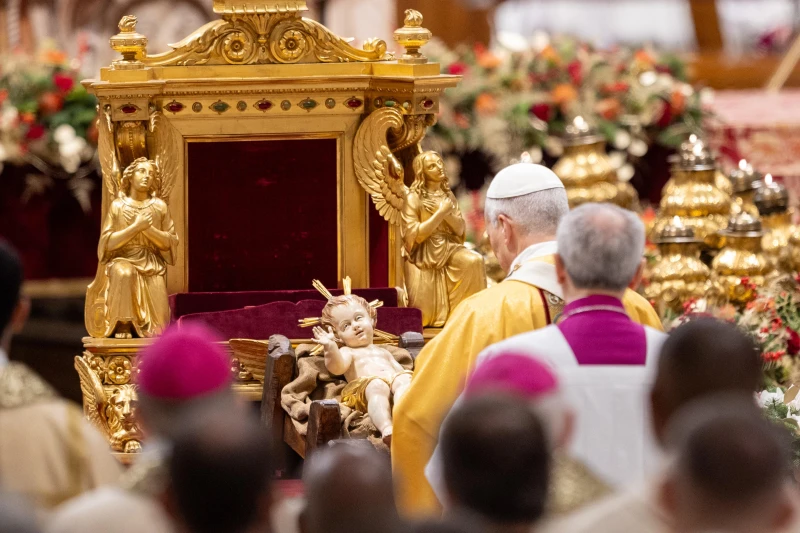Portiuncula chapel on the campus of Franciscan University of Steubenville. / Credit: Franciscan University of Steubenville
Denver, Colo., Dec 29, 2023 / 08:00 am (CNA).
According to the U.S. Conference of Catholic Bishops (USCCB), there are almost 250 Catholic colleges and universities in the U.S. Recent information from the Cardinal Newman Society, a nonprofit founded to promote and defend faithful Catholic education, shows that some have experienced remarkable growth over the past year.
In 2023, Belmont Abbey College in North Carolina welcomed its largest incoming class, marking an almost 10% increase from 2022, and Benedictine College in Atchison, Kansas, reported a record undergraduate class of 2,213 students — a 121% growth over the past 20 years.
Christendom College in Front Royal, Virginia, welcomed 172 new students to campus, reaching its 550 total student body size cap; the University of Mary in Bismarck, North Dakota, had the largest freshmen class in its history this year; and the University of St. Thomas-Houston also had a record-breaking number of new incoming undergraduate students. Wyoming Catholic College, one of the youngest Catholic colleges on the block, experienced continual growth as well.
CNA took a closer look at three Catholic universities that have experienced impressive growth in 2023, as well as one college that is preparing to close its doors.
Franciscan University of Steubenville: Catholic identity
Franciscan University of Steubenville has been steadily growing over the past seven years, with its largest freshman class of more than 770 students this fall — the largest class since its founding in 1946 according to the Cardinal Newman Society.
The school has grown in more than just enrollment, adding mechanical engineering and criminal justice programs in recent years, and is currently developing a doctoral program in theology.
The school also offers online courses geared to a varied audience — including high school students who can earn college credit through dual enrollment programs — and has a record high of 3,800 students enrolled both on campus and online.
Franciscan University of Steubenville in Ohio. Credit: Franciscan University of Steubenville
So what is Franciscan University doing differently?
“The culture on campus is really a huge draw for the students,” Dr. Stephen Hildebrand told CNA. Hildebrand is vice president for academic affairs and a theology professor at FUS.
The four Masses offered daily on campus are usually standing room only, he noted.
“Our conviction is that you can bring a Catholic identity to any discipline and it makes a difference, whether it’s nursing or criminal justice — it’s not just theology,” Hildebrand said. “That’s really our abiding conviction, that the Catholic faith has something to offer to all these different disciplines.”
As Franciscan University expands, it is “doubling down on our Catholic identity,” Hildebrand told CNA. Its criminal justice program is taught by a St. Thomas Aquinas expert, for instance.
“I would like our academic programs to grow both in extension and in depth,” Hildebrand added, noting several new graduate programs that are in progress. “I want to continue that trajectory of deepening the formation that we offer… In terms of extension, I’d like to grow our programs to reach disciplines and students that we haven’t yet reached.”
It’s not just programs that have to grow at FUS.
“We’re coming up against more limits in space and housing. Specifically, we’re just opening up our new classroom building in the fall of 2024,” John Herrmann, director of student financial services, told CNA. “Our vision is that we can house 2,000 students on our campus and our resident facilities.”
“We’re on the trajectory to again have another record class,” he said.
Thomas Aquinas College: Unique education
How can a campus grow when its enrollment capacity is 400 students?
The founders of Thomas Aquinas College (TAC) prioritized small student bodies to build a tight-knit community. Interest in the school grew over time, and in 2019, TAC opened a New England campus in Northfield, Massachusetts. The campus continues to expand and will increase its freshman class size next year by one-third.
Part of TAC’s challenge is preserving the campus culture on the new campus.
Because of this, the New England campus has had “a very steady but measured and deliberately slow rate of growth,” executive director of college relations Chris Weinkopf explained.
The exterior of the chapel at Thomas Aquinas College. Credit: Thomas Aquinas College
“We don’t have desks in our classrooms. Each one of our classrooms [has] a single large table that everybody sits around,” Weinkopf explained. “We don’t call our faculty ‘professors’; we call them ‘tutors,’ and the idea is that they’re not lecturing, they’re not professing — they’re guiding the conversation.”
“We require our faculty to teach across the disciplines too, because the students are going to be making the connections between the subject matter and these different classes,” Weinkopf said. “They need to have tutors who can help them make those connections.”
On its current track, the school hopes to reach 280 students in the next four years, but its ultimate goal is a campus of 400 students.
Applications to TAC have jumped 20% in the past year.
At this rate of growth, the New England campus is close to its limit on dining hall size. Weinkopf said that a shared dining hall is a key part of the TAC model, which is discussion-based.
“The founders were very much of the belief that this program of education, this pedagogy, that works through discussion, works best when that discussion is an endeavor that happens around the clock,” Weinkopf explained to CNA. “So yes, it begins in the classroom, but it doesn’t end in the classroom. It continues in the residence halls; it continues in the dining hall; it continues as students walk here and there.”
Catholic University of America: Faith life
The Catholic University of America (CUA), America’s oldest Catholic research university, experienced growth in enrollment and faith life this year while also anticipating future challenges.
The Washington, D.C.-based university welcomed its largest class of incoming students in recent years this fall and saw its highest number of applications in the past five years, according to Deanne Gipson. Gipson is the vice president of enrollment management for graduate and undergraduate studies at CUA.
“The future is very bright for us as we continue to strive for a goal set by President Peter Kilpatrick of having 10,000 students — graduate and undergraduate — enrolled within the next decade,” Gipson said.
Gipson noted that the college has seen a rise in both domestic and international graduate students and a 20% rise in undergraduate applications for fall 2024, well before the deadline.
CUA’s student body is also evenly split 50/50, male to female, which, according to the Cardinal Newman Society, runs contrary to higher education statistics showing women make up roughly 60% of U.S. college students.
But enrollment isn’t the only side of the university that is thriving.
Credit: Mehdi Kasumov/Shutterstock
“We are also seeing exponential growth in the faith life of the university as our campus ministry expands opportunities for students to grow in their love of God and devotion to the Church,” Gipson explained. “From celebrating Masses of inculturation to expanded ways to join fellow Catholics in prayer, the university seeks to ensure that our students are able to experience a life of faith and fellowship during their time on campus.”
The university struggled with staffing this year “due to the tight labor market for staff,” Gipson noted. Meanwhile, many universities, including CUA, are anticipating a drop-off in applications in 2025.
College tuition inflation is an increasingly relevant factor in students’ decisions to attend college.
According to the Education Data Initiative, the cost of college tuition has increased 747.8% since 1963, when accounting for inflation. But this year, college tuition is increasing at a rate slightly lower than the rate of inflation, according to December data from the U.S. Labor Department’s Bureau of Labor Statistics.
Catholic interest in attending college has been growing, however.
“In fact, one study by Gallup found that for those Catholics worshipping weekly or more often, their expected growth rate of college enrollment is 43.2% from 2019 to 2037 compared with a decrease of 10.3% for those Catholics who rarely or never attend Mass and a whopping 15.8% decline for non-Catholics,” Gibson observed. “This is very good news for the university, and we remain optimistic and look forward to the spring 2024 term and beyond.”
Magdalen College: A heartbreaking ending
Not all Catholic schools of higher education experienced growth in 2023, however. Magdalen College in Warner, New Hampshire, announced in the fall that the school will be closing at the end of this academic year.
Magdalen offers a bachelor’s degree in liberal studies with majors in philosophy, literature, theology, and history. The school champions a traditional Catholic identity and the study of liberal arts in small-group, Socratic-style discussions. The school also emphasizes fine arts, especially choral singing. Its choir is making a final tour this month.
“I am heartbroken that this will be Magdalen College’s final year,” said Ryan Messmore, who became president of Magdalen in July 2021. “After the college experienced some severe challenges in 2020 and was subsequently put on probation in 2021, we have been working hard to move things in a better direction. If we had had a few more years to continue this momentum, things might have been different. However, a significant loan came due this year that caused the board to announce the upcoming closure.”
The chapel at Magdalen College in Warner, New Hampshire. Credit: CanonLawJunkie, CC BY-SA 3.0, via Wikimedia Commons
Messmore said the college has been making arrangements for the students to complete their education by securing teach-out agreements with six different Catholic institutions.
Most of the students will finish out a final semester at Magdalen in the spring.
“We understand and share the heartbreak of our students, faculty, staff, and alumni, and we will continue to work closely with them to succeed through this transition,” Messmore continued. “I am particularly grateful for the benefactors who have given to the college over the past month to help ensure that our faculty and staff can remain employed through May 2024, providing them the time they need to figure out their next steps.”
“God has been faithful to Magdalen College for 50 years, and we trust that we are in his hands even now,” he said.











